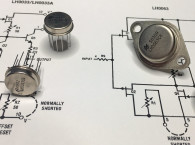
Available in surface-mount and ROHS-compliant versions, the LSK 489 is an improved, functional replacement for JFETs that have similar noise characteristics but greater gate-to-drain capacitance. The LSK 489 SOT-23 and SOIC packages are ideal for space-limited circuits in audio and instrumentation applications. LSK 489 available packages are: TO-71; SOT-23-6L, SOIC-8L. The LSK 489 combines a noise level nearly as low as the LSK 389 with lower gate-to-drain capacitance, 4 pF vs. 25 pF.
The LSK 389 and the LSK 489 feature unique monolithic dual-design construction, interleaving both JFETs on the same silicon piece to provide thermal tracking and a low-noise profile. Lead-free, ROHS-compliant versions are available. Linear Integrated Systems’s in-house fabrication and domestic factory stock guarantee short lead times, ensuring no disruption in production schedules.
The LSK 489 can be used in several applications (e.g., microphone amplifiers, phono preamplifiers, audio amplifiers and preamps, discrete low-noise op-amps, battery-operated audio preamps, audio mixer consoles, acoustic sensors, sonic imaging, instrumentation amplifiers, wideband differential amplifiers, high-speed comparators, and impedance converters.
For more information, visit www.linearsystems.com






